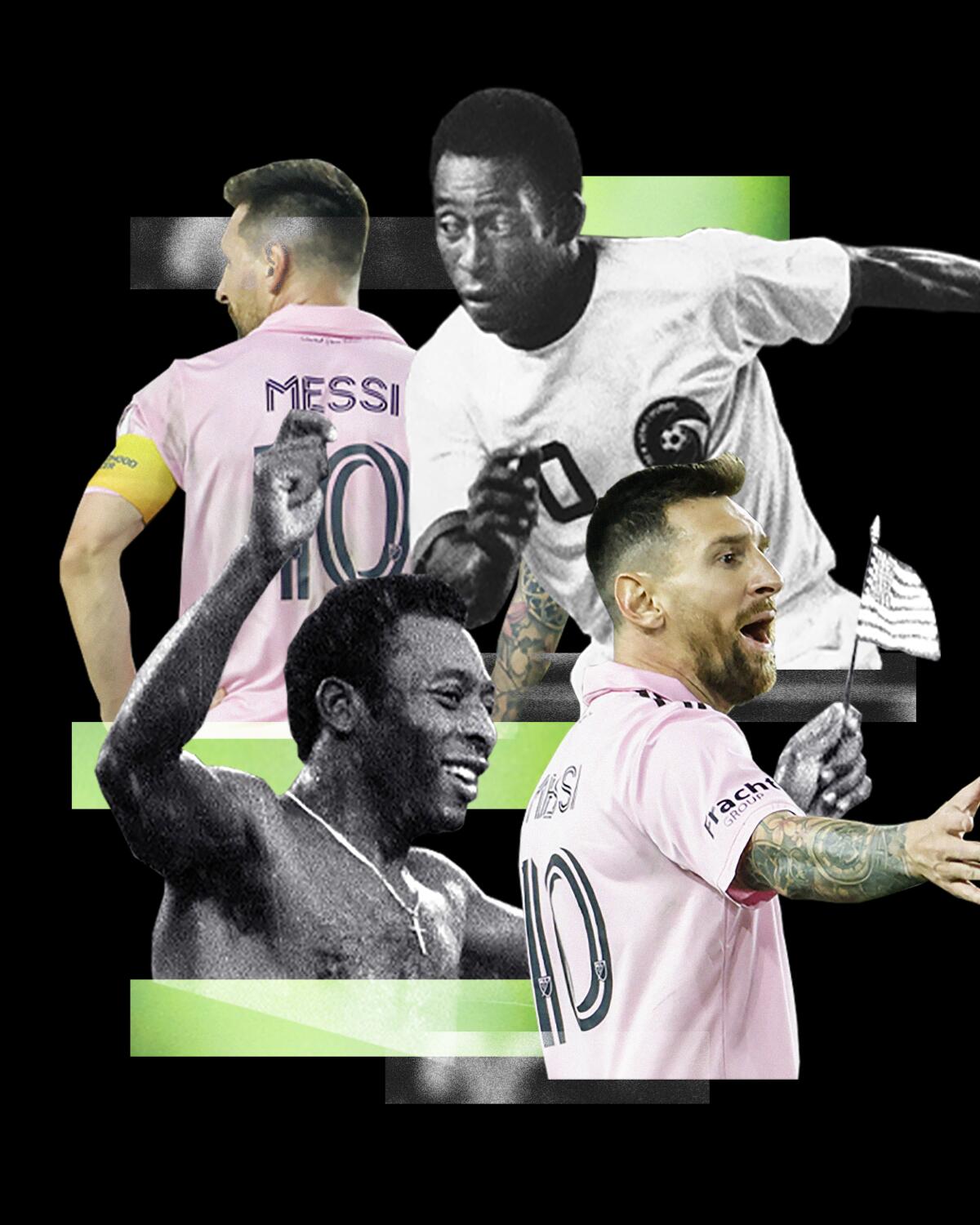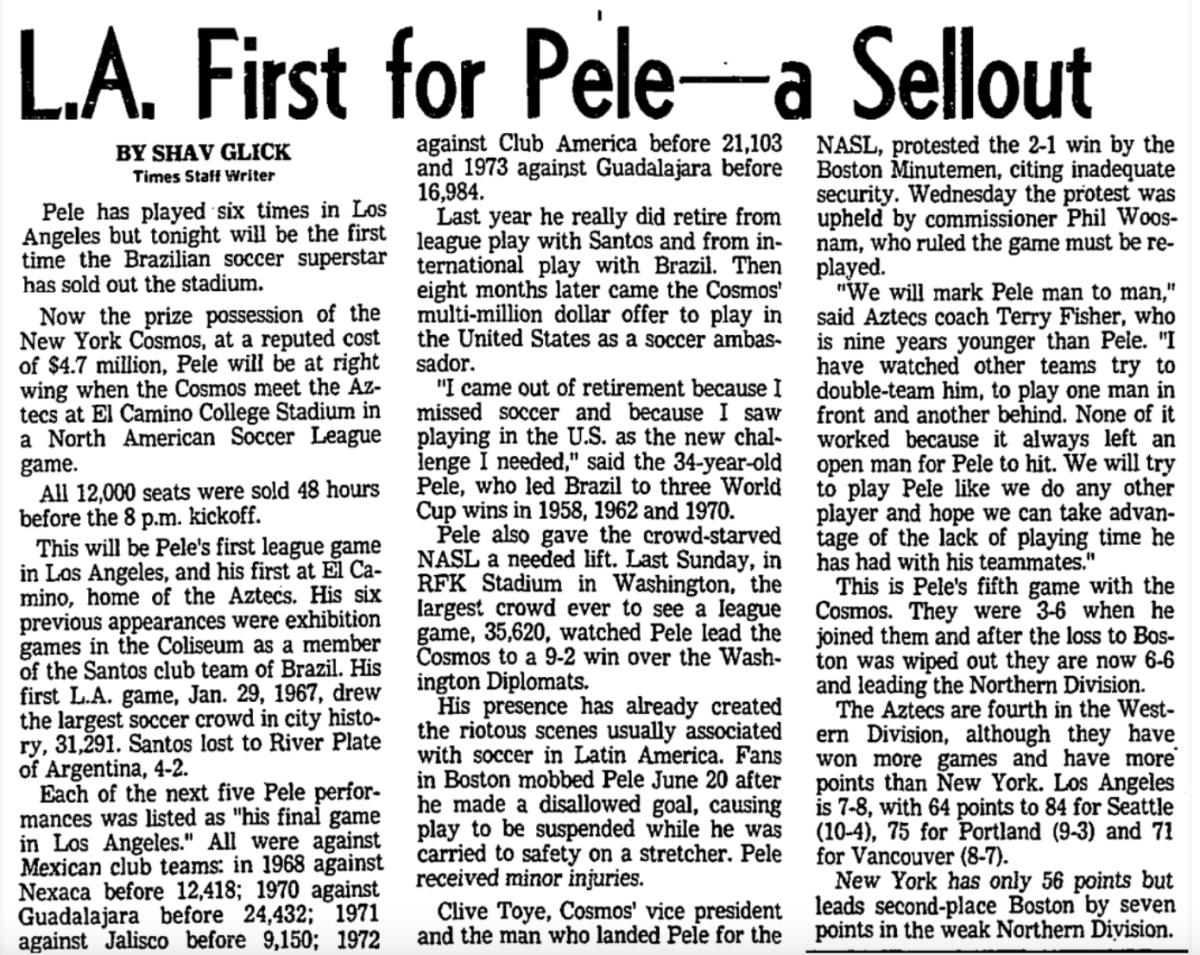Latinx Files: U.S. was a soccer country way before Messi’s arrival

Before Inter Miami’s charter bus could make its way past the hundreds of Lionel Messi fans assembled outside BMO Stadium on Hoover Street late Sunday afternoon, it had to make its way south on Figueroa.
I was standing in the tailgate area outside the venue, interviewing LAFC die-hard fans for the De Los live blog, when I saw it inch its way through traffic. The bus was all blacked out, of course, but that didn’t stop people around me from rushing to the sidewalk to hurl their vitriol and flip their birds.
It was at that moment, surrounded by tailgaters and people trying to make an honest buck off them (paleteros, hot dog vendors and people with coolers selling shots of Patrón for $10, just to name a few), that the magnitude of what would transpire later that evening really hit me.
This match is a really big deal, I thought to myself.
f
Eloquent and insightful, I know, but it’s no less true.
For starters, its eventual outcome would be of consequence— the 3-1 victory for Inter Miami kept the club’s long shot hopes of making the MLS playoffs alive.
It also turned out to be a big challenge for the home fan base. Since LAFC’s inception, the 3252, a Voltron-like supporter group made up of smaller supporter groups, has prided itself in turning BMO Stadium into a hostile environment for visiting teams. On Sunday, however, that reputation was put to the test. Though they were as loud and energetic as ever, there were plenty of fans wearing pink and albiceleste jerseys cheering right back.
As my colleague Dylan Hernández wrote in his column about the game, fans in attendance were given a “chance to share stories with their children, or even grandchildren, of seeing the greatest soccer player of his generation play the world’s most popular game in a way only he could.”
Among the VIPs who showed up to watch the L.A. stop of Messimania were several music and Hollywood stars, two Spider-Men, a royal couple and one basketball king.
The Latinx experience chronicled
Get the Latinx Files newsletter for stories that capture the multitudes within our communities.
You may occasionally receive promotional content from the Los Angeles Times.
Sunday’s match was many things — but one thing it wasn’t was proof that soccer has finally made it in the United States.
After all, the sport has been thriving in this country for decades, long before Messi’s and David Beckham’s arrival, well before Apple released “Ted Lasso.”
To go back even further, the beautiful game had taken hold in the U.S.— or at the very least Los Angeles — even before Pelé came out of semi-retirement to play for the now-defunct North American Soccer League in the mid-’70s.
Curious about the last instance in which a soccer player deemed to be the greatest of all time joined an American club in the waning years of his career, I asked The Times’ library team to help me dig up our coverage of Pelé’s visits to our fair city during his stint with the New York Cosmos.
One story in particular, a game preview from July 3, 1975, which you can find below, caught my attention.

What stood out to me about that report wasn’t that Pelé had sold out an L.A. sporting venue for the first time — 12,000 people in attendance isn’t impressive; I’ve been to Texas high school football games that have been bigger.
The part that struck me was learning that his previous six visits to Los Angeles were to play exhibition matches against Latin American teams as a member of Brazilian side Santos FC; and that all but one of these matches outsold his NASL sellout.
Even more surprising was finding out that Pelé’s match against Argentinian side River Plate (31,291 fans) and Mexico’s Club Deportivo Guadalajara (24,432 fans) had more people in attendance than Sunday’s LAFC match (22,921 fans).
And you better believe that the majority of these fans were Latinx.
“The crowd was a complete turnabout from the 31,000 who saw Pele in his first Los Angeles appearance in 1967,” wrote Times staff writer Shav Glick in a follow-up recap story (the L.A. Aztecs handily defeated the New York Cosmos, 5-1).
“At the time there was little English spoken — except by British soccer followers— in the Coliseum. It was mostly a Latin crowd.”
Aside from language preference and the exponential growth of the sport at the global level, little has changed when it comes to who makes up your average soccer fan in this country. Though the sport has become popular among non-Latinxs thanks to MLS, the World Cup dynasty of the U.S. women’s national team and the recent emergence of the men’s team as a CONCACAF powerhouse, it has long been a historical staple of Latinx communities in this country.
This is especially true for the Mexican diaspora, whose obsession with soccer at the Liga MX and national team level has been essential to the success of both Spanish language networks, This compulsion has also been monetized by companies associated with El Tri—the most popular soccer team in the country—and its never-ending U.S. tour.
Sunday was no different. The crowd privileged enough to witness Messi’s greatness was certainly diverse, but it was impossible to ignore just how Latinx the vibe felt at BMO Stadium. Sitting in the press box and looking out to the sea of black, gold and pink, it felt like a reminder that fútbol culture is very much here to stay.
It probably didn’t hurt that the two biggest stars on the pitch— Messi and LAFC’s Carlos Vela— are Latin American.
Consider subscribing to the Los Angeles Times
Your support helps us deliver the news that matters most. Become a subscriber.
Things we read this week that we think you should read
— While Mexican President Andrés López Obrador’s government boasts about the gains made by the peso, citizens who depend on remittances from the United States are paying the price. In his latest, my colleague Patrick J. McDonnell lays out the ramifications of what the “super-peso” has meant for some of Mexico’s poorest. In one town in Oaxaca state, construction has come to standstill because the cost of supplies has gone up since the U.S. dollar isn’t the financial lifeline it once was. There doesn’t seem to be an easy fix on the horizon; the peso continues to strengthen while the U.S. dollar weakens, meaning many of the poorest will struggle even more for their basic necessities.
— Julio Urias had everything in front of him. A million-dollar bank account, more coming thanks to his upcoming free agency and the adoration of millions of Dodger fans. The Mexican pitcher was placed on administrative leave Wednesday after his arrest for felony domestic violence following the LAFC vs. Inter Miami match on Sunday. While the specifics of the incident are not yet known, this is the second time Urias has been arrested for domestic violence as a Dodger. In 2020, he was arrested after an altercation near the Beverly Center, but wasn’t charged. As Bill Plaschke rightly points out, this should mark the end of Urias’ Dodgers career and puts in jeopardy his future in MLB.
The Latinx experience chronicled
Get the Latinx Files newsletter for stories that capture the multitudes within our communities.
You may occasionally receive promotional content from the Los Angeles Times.




